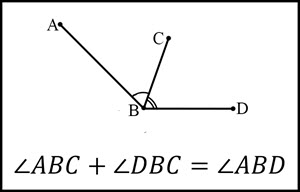Intro
A point has no dimension. It gives a location.
A line has 1 dimension. It extends forever in both directions.
A line segment has 1 dimension. It is a section of a line between two points.
A ray has 1 dimension. It is part of a straight line that extends forever in one direction from a fixed point.
A plane is a flat surface of 2 dimensions.
Practice Problems
True or False?
\(\textbf{1)}\) You can name a plane with collinear points.
\(\textbf{2)}\) You only need two points to name a line.
\(\textbf{3)}\) Any two points are collinear.
\(\textbf{4)}\) Any three points are collinear.
\(\textbf{5)}\) Any three points are coplanar.
\(\textbf{6)}\) A point has no dimension.
\(\textbf{7)}\) Coplanar points are points that lie on the same plane.
\(\textbf{8)}\) A plane has two dimensions.
\(\textbf{9)}\) A line has two endpoints.
\(\textbf{10)}\) A line segment has two endpoints.
\(\textbf{11)}\) The intersection of two different lines is a point.
\(\textbf{12)}\) The intersection of two different planes is a line.
\(\textbf{13)}\) A line has 2 dimensions.
\(\textbf{14)}\) A plane has 2 dimensions.
\(\textbf{15)}\) Rays have only one endpoint.
\(\textbf{16)}\) Ray \(\vec{AB}\) is the same as Ray \(\vec{BA}\)
\(\textbf{17)}\) Line segment \(\overline{AB}\) is the same as line segment \(\overline{BA}\)
\(\textbf{18)}\) A plane has 3 dimensions.
See Related Pages\(\)
\(\bullet\text{ Geometry Homepage}\)
\(\,\,\,\,\,\,\,\,\text{All the Best Topics…}\)
\(\bullet\text{ Segment Addition Postulate}\)
\(\,\,\,\,\,\,\,\,AB+BC=AC…\)
\(\bullet\text{ Angle Addition Postulate}\)
\(\,\,\,\,\,\,\,\,\)
In Summary
Points, lines, rays, segments, and planes are all fundamental concepts in geometry.
A point is a location in space. It is represented by a dot and is usually labeled with a capital letter.
A line is a straight path that extends infinitely in both directions. It is represented by a straight line with arrows at both ends, indicating that it extends indefinitely.
A ray is a part of a line that starts at a specific point and extends indefinitely in one direction. It is represented by a line with an arrow at one end, indicating the direction in which it extends.
A segment is a part of a line that has two endpoints. It is represented by a line with two dots at either end, indicating the start and end points of the segment.
A plane is a flat surface that extends indefinitely in all directions. It is represented by a four-sided figure with straight sides.
These concepts are important building blocks for understanding more complex geometric shapes and concepts, such as circles, triangles, quadrilaterals, and three-dimensional shapes.
Points, lines, rays, segments, and planes are typically introduced in a geometry class, which is usually taken in high school as part of a student’s mathematics curriculum. They form the basis for the more complex geometric shapes and concepts that students will encounter in their geometry class. Overall, geometry class is an important part of a student’s mathematics education, as it helps to develop their spatial reasoning skills and lays the foundation for more advanced studies in mathematics and other related fields.
Some topics to Points, Lines, Rays, Segments, and Planes
Angles: Angles are formed when two lines or rays intersect at a point. There are different types of angles, such as acute angles, right angles, and obtuse angles, and they are measured in degrees.
Triangles: Triangles are three-sided polygons that are formed by three non-collinear points connected by segments. There are different types of triangles, such as right triangles, isosceles triangles, and equilateral triangles, and they have specific properties based on their sides and angles.
Quadrilaterals: Quadrilaterals are four-sided polygons that are formed by four non-collinear points connected by segments. There are different types of quadrilaterals, such as squares, rectangles, and parallelograms, and they have specific properties based on their sides and angles.
Circles: Circles are geometric shapes that are formed by all points in a plane that are a fixed distance from a center point. Circles can be used to solve problems involving arcs, sectors, and chords.
Three-dimensional figures: Three-dimensional figures are geometric shapes that have three dimensions: length, width, and height. Examples of three-dimensional shapes include prisms, pyramids, cylinders, cones, and spheres.
Points, lines, rays, segments, and planes make up the basis for so much of what we study in geometry class.
Andymath.com is a free math website with the mission of helping students, teachers and tutors find helpful notes, useful sample problems with answers including step by step solutions, and other related materials to supplement classroom learning. If you have any requests for additional content, please contact Andy at tutoring@andymath.com. He will promptly add the content.
Topics cover Elementary Math, Middle School, Algebra, Geometry, Algebra 2/Pre-calculus/Trig, Calculus and Probability/Statistics. In the future, I hope to add Physics and Linear Algebra content.
Visit me on Youtube, Tiktok, Instagram and Facebook. Andymath content has a unique approach to presenting mathematics. The clear explanations, strong visuals mixed with dry humor regularly get millions of views. We are open to collaborations of all types, please contact Andy at tutoring@andymath.com for all enquiries. To offer financial support, visit my Patreon page. Let’s help students understand the math way of thinking!
Thank you for visiting. How exciting!